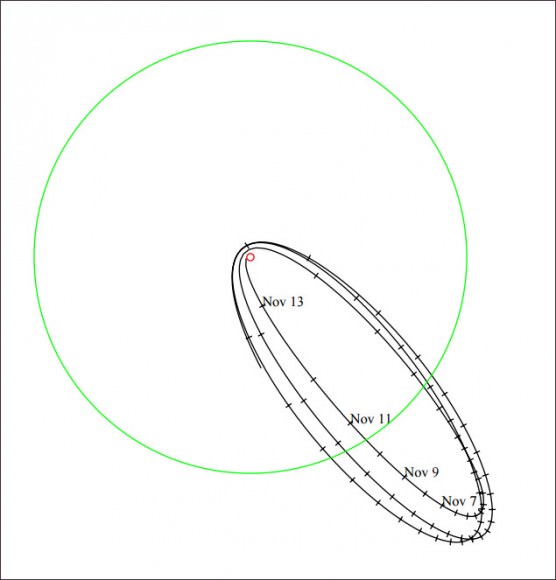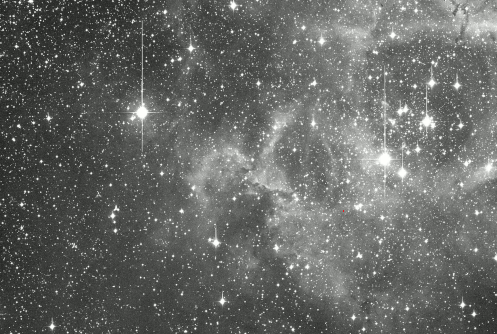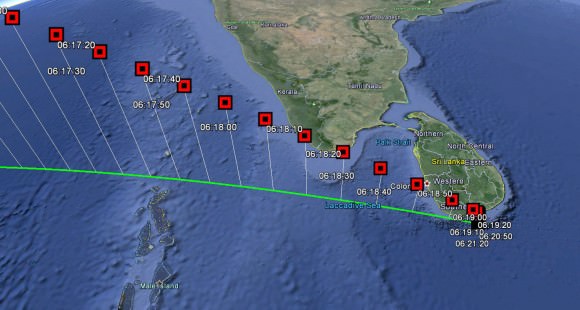No one’s 100% certain what WT1190F is — asteroid or rocket stage — but we are certain it will light up like a Roman candle when it re-enters Earth’s atmosphere around 6:20 Universal Time (12:20 a.m. CST) tomorrow morning Nov. 13.
Animation by Jost Jahn of WT1190F’s final hours as it races across the sky coming down off the coast of Sri Lanka
As described in an earlier story at Universe Today, an object discovered by the Catalina Sky Survey on Oct 3rd and temporarily designated WT1190F is expected to burn up about 60 miles (100 km) off the southern coast of Sri Lanka overnight. The same team observed it twice in 2013. Based upon the evolution of its orbit, astronomers determined that the object is only about six feet (2-meters) across with a very low density, making it a good fit for a defunct rocket booster, possibly one used to launch either one of the Apollo spacecraft or the Chinese Chang’e 3 lander to the Moon.

Additional observations of WT1190F have been made in the past few days confirming its re-entry later tonight. Checking the latest predictions on Bill Gray of Project Pluto’s page, the object will likely be visible from Europe about an hour before “touchdown”. To say it will be moving quickly across the sky is an understatement. Try about 3 arc minutes per second or 3° a minute! Very tricky to find and track something moving that fast.

58 minutes later, in the minute of time from 6:18 to 6:19 UT, WT1190F will move one full hour of right ascension and plummet 34° in declination while brightening from magnitude +8 to +4.5. If you’d like to attempt to find and follow the object, head over to JPL’s Horizons site for the latest ephemerides and orbital elements. At the site, make sure that WT1190F is in the Target Body line. If not, click Change and search for WT1190F in the Target Body field at the bottom of the window.

You’ll find updates at Bill Gray’s site. According to the most recent positions, the object will pass almost exactly in front of the Sun shortly before plunging into the ocean. Sri Lanka’s capital, Colombo, is expected to get the best views.
Because the mystery object’s arrival has been fairly well publicized, I hope to update you with a full report and photos first thing tomorrow morning. Like many of you, I wish I could see the show.


Geeze.. I hope somebody gets a picture or radar image of that thing! I wonder if there’s a chance one of the new nano *.sat operators could get some imagery? THAT would be a coup for somebody? The ISS? Or… Theirry where are you?
I like your(?) idea that this object may be part of one of the Chinese lunar missions… sounds likely?
Aqua,
Hopefully the word’s out in Colombo and other locales in Sri Lanka. I do see online news sites reporting on it there. The more people, the better chance of images — at least of the breakup. This event is SO rare because if it’s an asteroid, we almost never see this stuff before it hits.
Ahem… I went over to Spaceflight101 and found this story about an observing campaign for this object. It shows the kind of equipment one would need to do the deed! They are mostly interested in getting the re-entry profile.. not pre re-entry images.
http://spaceflight101.com/wt1190f-on-approach-for-fiery-re-entry-on-friday/
Aqua,
Yep, that looks about right 🙂 Great equipment – everything from wide angle to telephoto. We’ll probably also be seeing more images from European amateurs later this evening as they track it before splashdown. Thanks for the link!
But the fiery atmospheric entry won’t be observed since it daytime and near the Sun, right? How does a magnitude of +4.5 compare to typical meteors? It takes -4 to be a fireball.
WT1190F? Shouldn’t that be, WTF1190??
WT1190F means:
WT = 2015, First half of October
1 = Observation made by the Catalina Smidt 1 telescope
190F = Hexadecimal number.
So one out of 16 observations had a WT …. F designation in the first half of October 2015.
source: http://blogs.esa.int/rocketscience/2015/10/28/assigning-the-wtf-to-wt1190f/